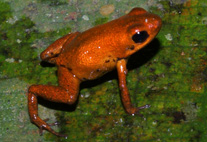Abstract
Dendrobatid frogs are among the best known anurans in the world, mainly due to their toxicity and associated bright colors. A recently described dendrobatid genus, Andinobates, comprises frogs distributed among the Colombian Andes and Panama. During field work in the Distrito de Donoso, Colón province, Panama, we found a poison frog that we here describe as a new species. The new species belongs to the A. minutus species group and is described herein as Andinobates geminisae sp. nov. This new species differs from all other members of the group by having uniformly orange smooth skin over the entire body and a distinctive male advertisement call. The new species is smaller than other colorful dendrobatids present in the area, such as Oophaga pumilio and O. vicentei. We also provide molecular phylogenetic analyses of mitochondrial DNA sequences of dendrobatids and summarize genetic distances among Andinobates species. Andinobates geminisae occurs in Caribbean versant rainforest on the westernmost edge of the known distribution of A. minutus, and represents the fourth species within this genus in Panama. This is vulnerable to habitat loss and excessive harvesting and requires immediate conservation plans to preserve this species with a restricted geographic range.

